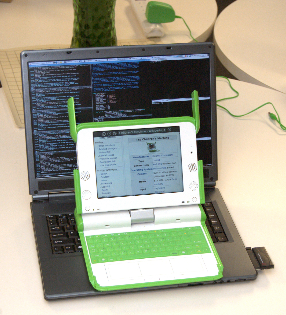Emulating the XO
Contents
Quick Start - LiveCD
For many, the LiveCD is the easiest way to try Sugar. It's easy to do, but your work is lost when you reboot.
Quick Start - Emulation
Emulation is the other way to try Sugar. It can be harder to set up,, but work is preserved.
- Sound in TamTam may not be working at the moment. MitchellNCharity 13:16, 5 June 2007 (EDT)
Quick Start for Developers
Developing on emulation is one alternative for developing software.
Get the latest image from here. (add link to tinderbox) Install QEMU and kernel acceleration as described in Emulating the XO/Quick Start. See /Help_and_tips#Development.
Builds 463,461,451 do not boot under qemu. 445 is known to work.
Overview
One way to run oplc software is using an emulator on your pc. See Getting started programming for other options.
Note Category:Emulation and Help and tips.
For play, you can use LiveCd or Quick Start.
For development, you can use LiveCd, or qemu (as in quick start, but with a different image), or perhaps one of the Developer Images other than the LiveCd. An alternate approach is to attempt installing sugar. See Getting started programming for a comparison.
A common development approach is to use QEMU with kqemu acceleration. See Quick Start for the basics. Though for development, we will use a different .img, one with a few extra utility programs. See OS images, including latest stable build.
Instead of qemu, you can run VMware, and there are additional options on a Mac.
Please report your experiences in User Feedback on Images. There is a Virtualization Common Room.
There are limitations with XO disk images.
The LATEST-STABLE-BUILD versus LATEST build distinction is mostly of interest to people running on actual XO's. In emulation, developers should usually use LATEST. And when STABLE is old, non-developers probably should too.
Comparison of alternatives
An OLPC laptop is custom hardware, running a stripped-down Red Hat linux, running Sugar. But what if you don't have a real olpc laptop? There are a several options, which can each be used in a couple of ways.
recomendations
| platform | purpose | recommendation |
|---|---|---|
| Windows | development | emulated xo disk image; or emulated Ubuntu with sugar-jhbuild; (or develoepr CD or LiveCD)?. (need your reports) |
| Mac | development | emulated xo disk image; or emulated Ubuntu with sugar-jhbuild; (or developer CD or LiveCD)?. (need your reports) |
| Mac with Parallels | development | install Ubuntu 32-bit, and Sugar on Ubuntu Linux. See /Mac. |
| Ubuntu 32-bit | development | Sugar with sugar-jhbuild and Sugar on Ubuntu Linux |
| 32-bit linux | development | Sugar with sugar-jhbuild |
| 64-bit linux | development | xo disk images under qemu; or LiveCd once it gets updated (currently it's April) |
- I don't really believe the development option of Windows/Mac developer/live CD. I've not yet heard of it actually being used. They are months out of date (April). But Mcfletch said (in May) it's an option, so I added it. MitchellNCharity 09:19, 23 June 2007 (EDT)
background
| option | updated | sound? | camera? | library? | etoys? | R/W? | development software? | net? | comments |
|---|---|---|---|---|---|---|---|---|---|
| Installing Sugar | continuous | yes | yes? | yes? | yes | yes | your own | yes | On some platforms, it takes time and space (hours and ~3GB), but "just works". On others, it is quite difficult to install. |
| Installing Sugar, on a virtual 32-bit Ubuntu, running in an emulator (qemu, parallels, or vmware) | |||||||||
| LiveCd | April | yes(boot) yes?(qemu) | yes?(boot) no(qemu) | no | yes | no | toolchain, Gnome | yes? | Alternative Quick Start. Can both be booted from, and used in qemu. Problems: A. |
| XO disk images: | |||||||||
| LATEST-STABLE-BUILD http://olpc.download.redhat.com/olpc/streams/development/LATEST-STABLE-BUILD/ | |||||||||
| ...development-ext3.img | ~monthly | yes/B | no | yes | yes | yes | no | after config | Quick Start for getting a look at Sugar. |
| ...development-devel_ext3.img | ~monthly | yes/B | no | no | yes | yes | a little | after config | |
| LATEST http://olpc.download.redhat.com/olpc/streams/development/LATEST/ | |||||||||
| ...development-ext3.img | ~daily | yes/B | no | yes | yes | yes | no | after config | |
| ...development-devel_ext3.img | ~daily | yes/B | no | no | yes | yes | a little | after config | Good for new developers (requires some command-line comfort). |
| OTHER | |||||||||
| FC6+Sugar | April | yes? | ? | ? | no | yes | Full Fedora Softare Dev. | yes | 6GB (April version: no etoys) |
Key:
- library: A library of sample content is included (english version). Ie, pretty text to web browse without having to get network.
- R/W (writable): With an .img, you can save things between sessions. With a .iso, your environment is the same each time you start.
- development software: are development tools included?
- Net (network): does the network "just work" or "manual" steps are required?
Problems:
- A: LiveCd (April) on fc6 x86_64, kernel panics under kqemu. A squashfs problem.
- B: Tam Tam is silent (though EToys makes noise). Cause unknown.
Notes:
- re "does sugar-jhbuild support camera/mic?": "yes, if the camera uses v4l2 and 640x480, I'd suspect so." Can someone confirm this? (#olpc, now) MitchellNCharity 00:16, 2 June 2007 (EDT)
Doables:
- Remove LiveCd's "?" above.
- Find out what's going on with Tam Tam sound. It would be nice for the xo disk images to all be sound-yes.
- Add a microphone column? Reconsolidate sound/camera/mic into a H/W column?
